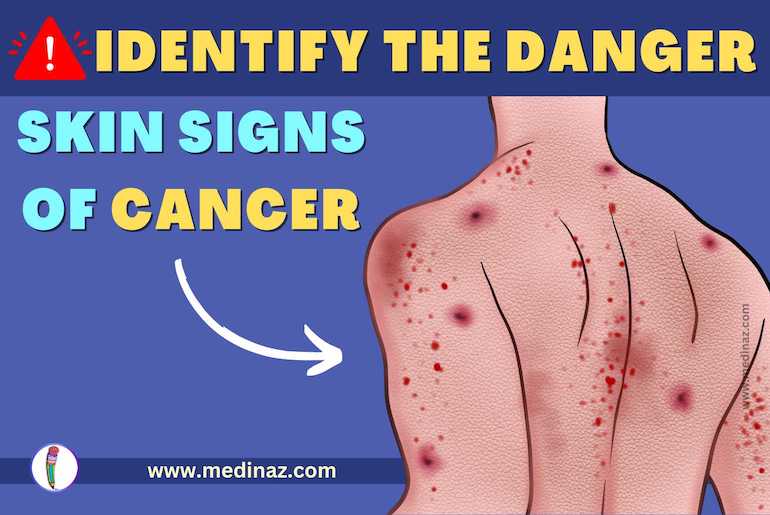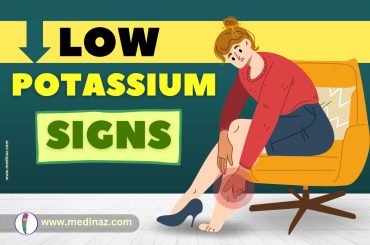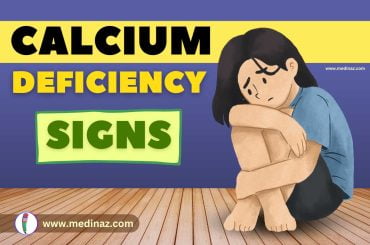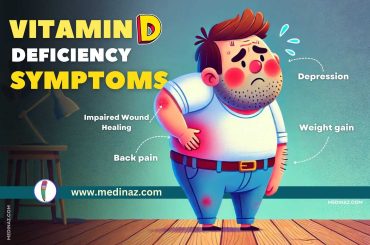Table of Contents
Understanding Skin Lesions: How to Identify Potential Signs of Cancer
Are you concerned about the health of your skin? Do you want to learn more about how to identify potential signs of skin cancer? Understanding skin lesions can be a crucial step in detecting and preventing this deadly disease. Skin lesions, such as moles, growths, or sores, can often be harmless, but they can also be warning signs of cancer.
It is essential to be able to differentiate between benign and potentially dangerous lesions to ensure early detection and treatment. In this article, we will delve into the world of skin lesions, providing you with the knowledge and tools you need to identify potential signs of cancer.
Whether you’re a healthcare professional or someone who simply wants to take better care of their skin, this guide will equip you with valuable information to protect yourself and your loved ones.
So, let’s embark on this educational journey together and empower ourselves with the knowledge to maintain healthy, cancer-free skin.
Types of Skin Lesions
Skin lesions can manifest in various forms, each with its own characteristics and implications. Understanding the different types of skin lesions is essential in identifying potential signs of cancer.
There are two main types of skin lesions: primary and secondary. Here is a breakdown of the types of skin lesions:
Primary Skin Lesions:
Macules: Small, flat spots on the skin that are typically discolored. Examples include freckles and flat moles
Papules: Small, raised bumps on the skin. They can be red, pink, or flesh-colored. Examples include acne and warts
Plaques: Large, raised patches of skin that are often red and scaly. They can be associated with conditions like psoriasis
Nodules: Solid, raised lumps in the skin that are larger than papules. They can be tender or painless. Examples include cysts and lipomas
Vesicles: Small, fluid-filled blisters on the skin. They can be clear or filled with pus. Examples include chickenpox and herpes
Pustules: Similar to vesicles, but filled with pus. Examples include acne pustules
Wheals: Raised, itchy areas of skin that are often red and surrounded by a pale halo. They are typically caused by an allergic reaction
Erosions: Areas where the top layer of skin has been lost. They can be moist or dry and are often painful. Examples include ulcers and blisters that have burst
Ulcers: Open sores on the skin that can be deep and may take a long time to heal. They can be caused by various factors, including infections and poor circulation
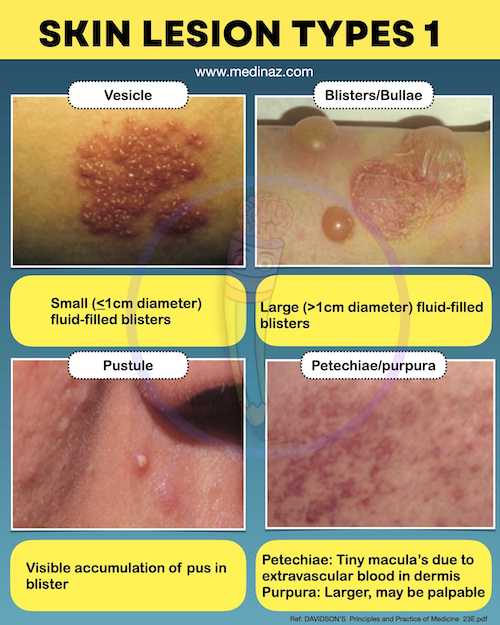
Secondary Skin Lesions:
Crusts: Dried blood, serum, or pus that forms a scab on the skin. They can be caused by scratching or infection
Scales: Flaky, dry patches of skin that can be caused by conditions like psoriasis or eczema
Scars: Fibrous tissue that forms after an injury or surgery. They can be raised or flat and may vary in color
Excoriations: Superficial scratches or abrasions on the skin. They are often caused by scratching or picking at the skin
Fissures: Deep cracks or grooves in the skin. They can be painful and are commonly seen in conditions like athlete’s foot and eczema
Understanding the characteristics and potential risks associated with each type of skin lesion is crucial for early detection and appropriate intervention.
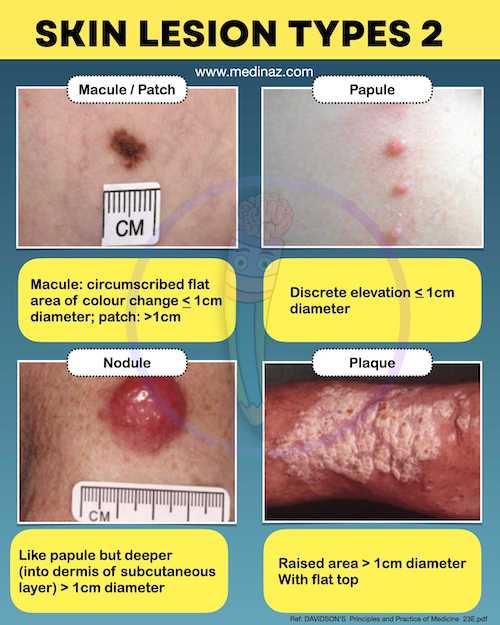
Common Causes of Skin Lesions:
Skin lesions can have various underlying causes, ranging from genetic factors to environmental influences. Some common causes include:
- exposure to ultraviolet (UV) radiation from the sun or tanning beds
- certain viruses, such as human papillomavirus (HPV) or herpes simplex virus (HSV),
- autoimmune disorders,
- genetic predispositions.
- Allergic reactions, such as bug bites or poison ivy
- Presence at birth, such as moles or birthmarks
- Sexually transmitted infections, like herpes simplex
- Thrombosis of skin lesions, which can cause pain (ref)
Additionally, injuries, infections, and chronic skin conditions, like eczema or psoriasis, can also contribute to the development of skin lesions.
It is important to note that while some skin lesions may be harmless, others may indicate the presence of cancerous cells. Understanding the potential causes behind skin lesions can help you assess your risk factors and take appropriate measures to protect your skin and prevent the occurrence of potentially dangerous lesions.
The Importance of Early Detection
Early detection is key when it comes to effectively treating skin cancer. The earlier skin cancer is diagnosed, the higher the chances of successful treatment and recovery. Regularly examining your skin and being vigilant about any changes or abnormalities can significantly improve the chances of detecting potential signs of cancer at an early stage.
By familiarizing yourself with your skin and its characteristics, you will be better equipped to identify any new or changing lesions. Remember, prevention is always better than cure, and early detection plays a crucial role in preventing the spread of skin cancer and minimizing its impact on your overall health.
Identifying Potential Signs of Cancer:
Identifying potential signs of skin cancer requires careful observation and knowledge of the warning signs.
- The most important indicators to look for are changes in the size, shape, color, or texture of existing moles or the appearance of new moles.
- Pay attention to any asymmetry, irregular borders, uneven color distribution, or diameter larger than a pencil eraser.
- Additionally, any moles that become itchy, bleed, crust, or fail to heal should be examined by a healthcare professional.
- Other warning signs include the development of sores or ulcers that do not heal, persistent redness or inflammation, or any growth that elevates above the skin’s surface.
These signs should not be ignored and warrant immediate medical attention for proper evaluation and diagnosis.
ABCDE Rule for Evaluating Skin Lesions:
To further aid in the identification of potential signs of skin cancer, the ABCDE rule can be used as a guideline. Each letter represents a characteristic to assess when evaluating a skin lesion.
A = A stands for asymmetry, meaning that the two halves of the lesion should be symmetrical.
B = B stands for border irregularity, which means that the edges of the lesion should be smooth and well-defined.
C = C stands for color variation, where a lesion should have a consistent color throughout.
D = D stands for diameter, with lesions larger than 6 millimeters being a cause for concern.
E = E stands for evolving, indicating any changes in size, shape, color, or symptoms over time.
By applying the ABCDE rule, you can enhance your ability to identify potential signs of skin cancer and seek appropriate medical attention when necessary.
When to Seek Medical Attention:
While some skin lesions may be harmless and resolve on their own, others may require medical intervention. It is important to know when to seek medical attention to ensure timely diagnosis and appropriate treatment.
If you notice any new, changing, or suspicious skin lesions that exhibit any of the warning signs mentioned earlier, it is recommended to schedule an appointment with a dermatologist or healthcare professional. They are experienced in evaluating skin lesions and can determine whether further diagnostic tests or treatments are necessary. Remember, it is always better to be safe than sorry when it comes to your health, especially when dealing with potential signs of cancer.
Diagnostic Tests for Skin Lesions:
Once you seek medical attention for a suspicious skin lesion, your healthcare professional may recommend various diagnostic tests to determine the nature of the lesion.
These tests may include a skin biopsy, where a small sample of the lesion is taken and examined under a microscope, or dermatoscopy, a non-invasive procedure that uses a specialized magnifying tool to examine the skin’s surface.
In some cases, imaging tests, such as ultrasound or MRI, may be utilized to assess the extent of the lesion or determine if the cancer has spread to other areas of the body.
The specific tests recommended will depend on the characteristics of the lesion and the suspected diagnosis. It is important to follow your healthcare professional’s guidance and undergo any necessary tests for an accurate diagnosis.
Treatment Options for Cancerous Skin Lesions:
If a skin lesion is diagnosed as cancerous, several treatment options may be available, depending on the type and stage of the cancer.
Common treatment approaches include surgical excision, where the cancerous tissue is surgically removed, radiation therapy, which uses high-energy X-rays to kill cancer cells, and chemotherapy, which involves the use of drugs to destroy cancer cells. In some cases, targeted therapy or immunotherapy may be recommended to specifically target cancer cells or boost the body’s immune system to fight the cancer. The choice of treatment will depend on various factors, including the type and stage of the cancer, the individual’s overall health, and personal preferences.
Your healthcare team will guide you through the treatment options and help you make informed decisions about your care.
Preventive Measures for Maintaining Healthy Skin:
While the occurrence of skin lesions cannot always be prevented, there are several measures you can take to maintain healthy skin and reduce your risk of developing cancerous lesions.
Firstly, protect your skin from harmful UV radiation by wearing sunscreen with a high SPF, seeking shade during peak sun hours, and wearing protective clothing, such as hats and long-sleeved shirts.
Regularly examine your skin for any changes or abnormalities, and if you notice anything suspicious, seek medical attention promptly.
Avoid excessive sun exposure and tanning beds, as they can significantly increase your risk of developing skin cancer.
Additionally, leading a healthy lifestyle, including eating a balanced diet, staying hydrated, exercising regularly, and avoiding smoking, can contribute to overall skin health and reduce the risk of cancerous lesions.
Conclusion:
Understanding skin lesions and being able to identify potential signs of cancer is crucial for maintaining healthy, cancer-free skin. By familiarizing yourself with the various types of skin lesions, common causes, and the importance of early detection, you can take proactive steps to protect yourself and your loved ones. By following the ABCDE rule and knowing when to seek medical attention, you can ensure timely diagnosis and appropriate treatment if needed. Remember, prevention and early detection are key in the fight against skin cancer.
By adopting preventive measures and leading a healthy lifestyle, you can maintain healthy skin and reduce your risk of developing cancerous lesions. Stay vigilant, take care of your skin, and empower yourself with the knowledge to make informed decisions about your health.
Check other Medinaz Health Blogs
A Visual Learning Platform

